Spanish Nationalist Tanks
 c280 Tanks and Armoured Cars 1936-39
c280 Tanks and Armoured Cars 1936-39
Understanding the Period:
The Spanish Second Republic (1931-1936) - Extremism and Instability
Following the ousting of General Miguel Primo de Rivera's dictatorship in 1930, radical Republicans eventually managed to gain power in 1931, forcing King Alfonso XIII to leave the country. A new Republic was declared on April 14th - the Second Spanish Republic. With this proclamation came an extremely controversial liberal constitution written by centrist and leftist radicals. Social, political, and economic tensions were already at breaking point at this time, but what made the nation so unstable and polarizing were the attempts by radical Republicans to force liberalism (by the centrists) and socialism (by the leftists) onto a traditionally deeply Catholic-conservative nation. This extremism on the part of the Republicans soon led to the rise of a reactionary right wing.Political Overview - 1931-1936
The Republic was characterized by several major factions, including two smaller regionalist factions:- The fairly moderate centrists (although they were considered fairly radical by previous standards of Spanish government) were some of the main players in the early Second Republic. For example, Alejandro Lerroux's PRR (Radical Republican Party) was the second largest party after the 1931 election, winning 90 seats in the Cortes. Similarly, Niceto Alcalá-Zamora's DLR (Liberal Republican Right - later PRP, Progressive Republican Party) was fairly significant. Alcalá-Zamora would also be elected president in December, 1931. These moderates (to just name a few, that is) would find themselves in increasingly difficult positions, trying to head governments with true extremists on both sides of the political spectrum, but also steer the sinking ship that was the Second Republic through a sea of social and political unrest. The centrists would effectively become irrelevant at the outbreak of the Civil War, if not, certainly by 1937.
- Leftists, Communists, Socialists, and Anarchists made up the bulk of the other Republicans, and Republican factions were usually in coalition for election time only - something to consider for when the Civil War breaks out. The PSOE (Spanish Socialist Workers' Party) headed by Julián Besteiro, won the most seats (a total of 115) in the 1931 election. Other such Leftist groups included the PCE (Spanish Communist Party), POUM (Workers' Party of Marxist Unification) and unions such as the UGT (General Workers Union), and anarcho-syndicalist CNT-FAI (National Confederation of Labor-Iberian Anarchist Federation). These groups were not united due to significant ideological differences. The various leftist factions were divided as much internally as they were with other non-left wing factions. This generally owed to their respective doctrines - for example, the Anarchist CNT-FAI would not even take part in democratic elections because such systems were ideologically unacceptable to them. Another example is that the PCE was usually subordinate to Moscow under Stalin, whereas POUM (formerly the ICE, Communist Left of Spain) was opposed to Stalin's Communism, and generally favored Leon Trotsky. The use of the term "Republicans" during the Civil War should not denote serious ideological unity beyond fighting the Nationalists.
- The right wing was generally comprised of old guard Monarchists, Fascists, Catholics, Conservatives, and traditional elites of the higher estates in previous Spanish states. Although they did not make huge gains until the general election of 1933, they also did not identify as a united front until that time. Included in these groups are CEDA (Spanish Confederation of Autonomous Right-wing Groups, founded in 1933), Falange Española (also 1933), the Carlists (traditionalist monarchists), and broadly speaking, these groups had the support of Alfonsists (loyal to King Alfonso XIII), and the Catholic Church. These sectors of society, facing extreme repression from Republicans, were on the whole, more united, and come the Spanish Civil War, easily more powerful militarily speaking.
- The Republic also had two regionalist powers at play - Catalonian separatists and Basque nationalists. The Catalonian separatists certainly held more power in the Republic than the Basques, not least because Catalonia was a bastion of powerful leftist groups such as the CNT-FAI, ComIntern members, and various other major and minor Communist factions. An almost comically reductionist (but nevertheless fair) interpretation of the Basque position is that they simply wanted to be left alone by a centralized Spanish state.
Regionalism from the Basque Country and Catalonia was ever-increasing and straining the unity of the Spanish Second Republic. Regionalism (or perhaps factionalism divided down regional line, IE the infighting between Anarchists of Catalonia and Communists of Madrid) could be easily argued as one of the most significant reasons that the Republicans crumbled before the Nationalists in the Civil War. Whilst the Nationalists factions, as we will explore later, were divided, too, their divisions were scratches compared to the chasms that divided the Republican front.
These tensions between factions rose steadily throughout the period between because the elections in 1931 gave power to the Republican Front. This front excluded the Anarchists and some other Leftist factions. Socialist/Communist-led social, agrarian, and industrial reforms failed, and the Republic effectively failed on its promises of a modernized state by 1933, leading to great resentment from many elements of Spanish society - particularly the traditional right, but also the general population.
The failure of such promised rapid changes led to a landslide victory for a center-right coalition, which won power in the 1933 election. The Republicans and leftists refused to accept the result - but they had been beaten at their own game. The newly formed Catholic-Conservative party, CEDA, won 115 seats in the Cortes (Spanish parliament), followed by Lerroux's centrist PRR, which won 102 seats. The PSOE of Francisco Largo Caballero had lost 56 seats (almost half of the seats won in 1931). In the background, the Basque Nationalists won 12 of 17 available seats, and leftist groups in Catalonia reformed into the Esquerra Catalana (Catalan Left). The new government was a coalition led by PRR and joined by CEDA.
The fallout of the 1933 election was significant on various levels. The military was purged of Republicans and was reformed - only those loyal to CEDA would receive any promotions. Farm workers' wages were halved, and farming practices were still inefficient - a lingering result of Republican reforms which led to further resentment for the Republic. Worse still, there were no budgets passed under the CEDA - PRR, so Spain suffered greatly economically.
The arrival of CEDA into government also caused the Asturian Miners' Strike of 1934, which was eventually crushed by none other than Francisco Franco, leaving 1700 miners dead, and anywhere between 15,000-30,000 arrested. As a result of the political and economic instability, in 1935, Manuel Azaña of the IR (Republican Left) and Indalecio Prieto of the PSOE began to organize leftist groups into the Popular Front (FP) in order to challenge the government.
Fresh elections in early 1936 were called after Lerroux's government collapsed as a result of CEDA's withdrawal of support, and a huge governmental corruption scandal. This fresh election saw the Republicans regain power through the Popular Front, but tensions had finally reached a breaking point within Spain.
The Spanish Civil War broke out in July 1936 with parts of the Spanish military elite declaring their opposition to the Republic. Planning had taken place months earlier, with the hope of a swift overthrow of the unstable Republican government. A coup broke out in Morocco, and various cities across (mostly) southern Spain, but rebels failed to take many cities outside the south, especially the powerful cities of Catalonia and Madrid.
The Republicans were not fast enough to react, the army being fairly inactive and ineffective, and local militias being unwilling to act, too, because of a lack of arms. It took until September (two months after the coup) for the Republic to organize itself beyond under-armed militias as a result of various factions within the left wing still vying for power at this crucial time. Due to this, the right-wing rebels managed to take Seville, an important landing point for Francisco Franco's troops, and rebels were able to make swift advances - one might easily argue that this was a key turning point in the history of Spain.
The Civil War Erupts
For the purposes of the war, Spain was divided thus - the "Republican" coalition, loyal to the elected government, counted the Socialist party (Popular Front), and factions like the PCE/POUM (Communists), CNT & FAI (Anarcho-syndicalists), and regional factions from the Basque Country and Catalonia wavered between local interests and the government. Opposing them was the "Nationalist" side, led by the rebel General Francisco Franco with the Carlists (Traditional Royalists), the CEDA (right wing), the Alfonsists (loyal to the king), and the Falange led by Franco, the Spanish Fascist party.Both sides found allies in Europe. The Republicans were unfortunate, as democratic nations like France and Great Britain remained neutral for the duration of the war (even despite French attempts to supply arms, they were bound by the non-intervention committee). The Nationalists had the full support (material and later with small manpower) of the fascists in Italy and Nazis in Germany .
Spain eventually found itself geographically cut in two. Franco led the offensive from the south, transporting his seasoned African troops with planes offered by Nazi Germany, and trying to revive a "reconquista" in reverse.
Things went badly for the Republicans at first, mainly because of a lack of firepower, munitions, and logistics, which meant that local military forces (both militia and official army) were unable to mobilize and defend against advancing rebel forces. The defense largely seemed to be organized (to use the term loosely) using undrilled militias with archaic rifles, dynamite, and improvised gun trucks. The Republicans (whether militias or the official army) found its military might wanting.
The Division "Azul" in Operations (1941-45)
Although Spain was exhausted and neutral, Franco was convinced by Hitler to participate in the "crusade against the Bolshevism". Since Germany had the industrial muscle but needed manpower, an entire division of volunteers and career officers was integrated into the German high command organization and entirely German-equipped, from uniforms to tanks.Carro de combate Verdeja
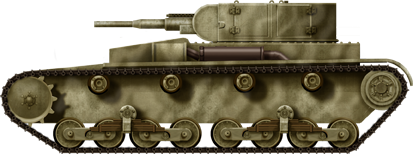
Designed by artillery commander D. Felix Verdeja Bardales, this tank is yet another attempt of the Iberian arm industry to build a small, yet successful tank. With revamped suspension and tracks, the engine relocated to the front, in the right part of the hull, and a small silhouette (only 1.75 m/5.74 ft high), the Verdeja was a difficult target and proved to be very agile in tests carried under operational conditions.Pre-Civil War Tanks and Armored Cars
Renault FT and TSF
Spain was interested in purchasing FTs from France as early as 1918. Between 1919 and 1923, Spain would receive 11 FTs and 1 TSF command tank. At the outbreak of the Civil War, 10 FTs were in service - 5 were in service with the Nationalists at Sevilla, and 5 were in service with the Republicans in Madrid. The fate of the TSF is unknown - it was likely out of service at that time. Poland and France also sold Spain 65 additional FT tanks during the course of the Civil War.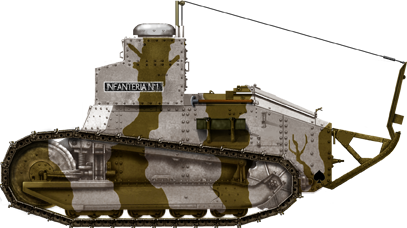
Spanish TSF tank, in Morocco.
Trubia Serie A
The Trubia Project included various prototypes of the Trubia design. The Trubia Serie A was the first indigenous Spanish tank, but it was a mere prototype. The main design feature was the turret, which was sectioned off into lower and upper sections. Each section had a Hotchkiss machine gun, and could be independently aimed. After successful testing of this prototype, development was given the green light.A second prototype was designed with new features, including an enlarged hull, a hull machine gun, new tracks, bigger engine. Commonly referred to as the Trubia A4, the first prototype was made in 1926, with three or four more ordered. It took until 1934 to have all four complete. The original prototype was sent back the factory in 1935 for upgrades. Several tanks were issued to, and tested by the Milan Infantry Regiment, which would later be turned over to the Nationalists in the early Civil War. The first prototype was still at the Trubia factory by the outbreak of war, and was given to the Republicans.
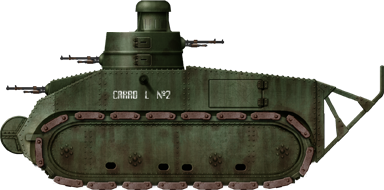
Trubia modelo A4, prototype n°2, without mudguards. It was attached to the Infantry Regiment Milan 32, which later took part in the defense of Oviedo. The "L" stood for Legero (light).
Bilbao armored car
Built in series at Bilbao, used mainly by the police. 4 crew, 5 soldiers. One MG turret. Speed 50 km/h (31 mph).Hispano Suiza MC-36
Built in competition with the Bilbao as a policing vehicle. It was based on a large Hispano Suiza truck chassis. It lost out on the contract to the smaller Bilbao, but saw limited production run of 5-15. It would later be thrown into the furnace of the Civil War, with some captured by the Nationalists. Most photographs show Nationalist service, as they were captured early on in the war. One was also given a T-26 turret in Nationalist service and was the command vehicle for A grupacion de Carros del Sur. Used postwar, too.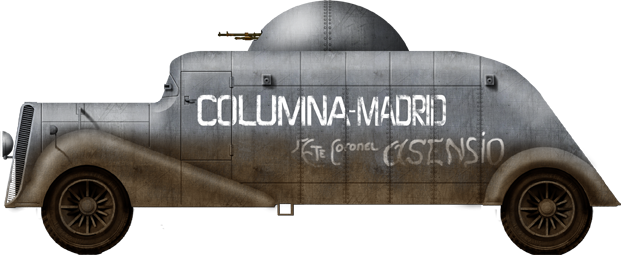
Rendition of the original Hispano Suiza MC-36 model featuring the 'Hotchkiss hemispheric turret'. Nationalist service. Slogan: "Columna Madrid Tte. Coronel Asensio".
Civil War Tanks and Armored Cars
T-26
An estimated 281 T-26s were sent to Spain from the USSR. These vehicles were paid for in gold, via a Republican-owned bank account set up in Moscow. Due to their 45mm 20kl gun, they were much deadlier than any other vehicle of the war. In Republican service, they were operated by Soviet crews only, but these often fell into the hands of Nationalists, who made good use of them.
T-26 M1933 (in reality produced in 1936) T-26 of the Nationalist forces, Battle of Guadalajara, March 1937.
CCI tipo 37 (Nationalist)
The Carro de Combate de Infanteria Tipo 1937, or infantry Combat Tank type 1937, was a Spanish prototype built by the naval base at Sestao for the Nationalist Forces. Only one prototype was made, armed with an Italian Breda 20 mm (0.79 in) autocannon and twin Hotchkiss light machine guns in the hull.UNL-35
Light armored car. 120-200 produced 1937-1939 in Valencia for Republican forces. Inspired by the FAI or BA-20. Various machine guns such as the DT, MG-08, and MG-13. Many would be captured by Nationalists and probably used until the 50s or 60s.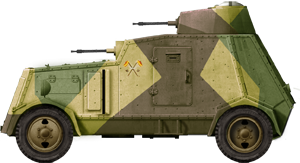
UNL-35 in Republican colors 2nd division armored cars, Barcelona, 1937.
AAC-1937 (Chevrolet 6x4)
Heavy 6x4 armored car. 70-90 produced 1937-1939 in Valencia for Republican forces. Inspired by the BA-3/6 and BAI - small differences help to distinguish the AAC-1937 from their Soviet counterparts such as fenders and engine hatches. Armaments varied between production batches. Some had small turrets with MGs, or 37mm guns, others had salvaged Soviet 45mm turrets. Many captured by the Nationalists and confiscated by the French after the retreat north (1939). These would eventually see service in WWII at first with France, but these were captured by Germany and were used on the Eastern Front.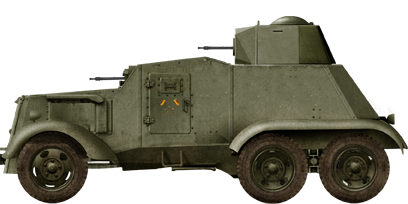
Republican AAC-37 in green livery. Turrets are believed to have just been armed with single machine guns, originally. Others would receive 37mm Puteaux guns.
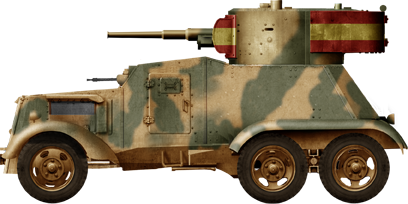
Nationalist captured AAC-37 with a Soviet 45mm gun turret. It is unclear whether these were salvaged from BT-5s, T-26s, or BA-3/6s - possibly all were used.
Ferrol armored car
Built at the Ferrol naval yard, one turret and 14 pistol ports.Mercier II armored car
Based on a track chassis, built at the Mercier Factory (Nationalist side). Single turret and Hotchkiss LMG.Ebro armored car
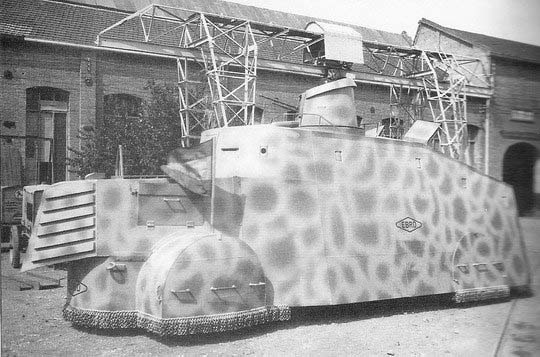
Ebro armored car. One of the numerous used by the Republicans during the Civil War, built in local city workshops, mostly on truck and bus chassis. They were generally characterized by a single turret and many pistol ports, and chains protecting the tires.
Links/sources
“Los Medios Blindados en la Guerra Civil España: Teatro de Operaciones del Norte 36/37” by Artemio Mortera Pérez“Los Medios Blindados en la Guerra Civil Española: Teatro de Operaciones de Levante, Aragón, y Cataluña, 36/39 1a parte” by Artemio Mortera Pérez.
“Los Medios Blindados en la Guerra Civil Española: Teatro de Operaciones de Levante, Aragón, y Cataluña, 36/39 2a parte” by Artemio Mortera Pérez.
"Los Medios Blindados en la Guerra Civil Española: Teatro de Operaciones de Andalucia y Centro 36/39" by Artemio Mortera Pérez.
“Blindados Españoles en el Ejército de Franco 1936-1939” by Lucas Molina Franco, and Jose Manrique Garcia.
“La Maquina y la Historia No. 2: Blindados en España: 1a. parte: La Guerra Civil 1936-1939” by Javier de Mazarrasa
“Las Armas de la Guerra Civil: El Primer Estudio Global y Sistematico del Armamento Empleado por Ambos Contendientes” by José María Manrique García and Lucas Molina Franco
“Spanish Civil War Tanks: The Proving Ground for Blitzkrieg” by Steven J. Zaloga “La Base Alemana de Carros de Combate en Las Arguijuelas, Caceres (1936-1937)” by Antonio Rodríguez González
"Soldiers of Von Thoma: Legion Condor Ground Forces in the Spanish Civil War 1936-1939" by Lucas Molina Franco, José Mª Manrique García, and Raúl Arias Ramos
"Arms of the Spanish Republic, A Nationalist Overview, 1938" by Lucas Molina Franco, and José Mª Manrique García.
“Camion Blindado Bilbao Mod. 1932 “Lanzallamas“.pdf” by Ángel P. Heras. “AFV Collection No. 1: Panzer I: Beginning of a Dynasty” by Lucas Molina Franco. “Tout les blindés de l’armée française 1914-1940” by Francois Vauvillier
“Revista policía Armada y de Trafico” (1941-1942)” Ministerio de la Gobernación España.
“Revista Policía”. Artículos de José Eugenio Fernández Barallobre” Ministerio del Interior, 2003-2004.
“Colección de Ordenes generales de la Inspección General de la Policía Armada y de Trafico”, Archivo Histórico del Ministerio del Interior. “Comintern and the Spanish Civil War” by Svetlana Pozharskaya “The Battle for Spain, The Spanish Civil War 1936-1939” by Anthony Beevor “A Short History of: The Spanish Civil War” by Julian Casanova
“The Spanish Civil War” by Stanley G. Payne
Spanish Civil War AFVs |
|||||||
|
|
||||||
| Model | Builder's location | Numbers | Year(s) | Model | Builder's location | Numbers | Year(s) |
| Trubia A4 | Trubia | 1 | 1934 | Trubia A4 | Trubia | 3 | 1928-1934 |
| Landesa Improvised Tank | Trubia | 1 or 2 | Unknown | Mercier | Zaragoza | 1 | 1936 |
| Sadurni de Noya | San Sadurní d'Anoia | 6 | 1937 | Carro de Combate de Infantería | Bilbao | 1 | 1937 |
| Trubia Naval | Sestao | 15-20 | 1936-37 | Verdeja | Zaragoza | 1 | 1938 |
| Barbastro | Barbastro | 1 | 1936 or 1937 | ||||
| Hispano Suiza MC-36 | Barcelona | 5-15 | 1935-1936 | ||||
| UNL-35 | Valencia | 120-200 | 1937-1939 | ||||
| AAC-1937 | Valencia | 70-90 | 1937-1939 | ||||
Foreign supplied |
|||||||
| Renault FT | France | 70 | 1918-1923 and during the Civil War | Renault FT | France | 5 | 1918-1923 |
| Schneider CA-1 | France | 6 | 1921 | L3/33 & L3/35 | Italy | 155 | 1936-39 |
| Vickers 6-ton | Great Britain (via Bolivia) | 1 (Unverified) | 1936 | Panzerkampfwagen I (Negrillos) | Germany | 122 | 1937-39 |
| T-26 | USSR | 281 | 1937-39 | Around 50 captured T-26s | |||
| BT-5 | USSR | 50 | 1938 | Unknown number of captured Renault FTs | |||

WW2 Tanks




























WW2 tanks posters

All Tiger tanks liveries.

Panther liveries and variants

WW2 Armour - All tanks











Tanks aces and single tanks series

Find more there

Museums, Movies, Books & Games
The Tanks and Armor in pop culture
Tanks and armored vehicles in general are only really grasped when seen first person: The mass, the scale, it's all there. Explore also the way tanks were covered in the movie industry, in books and in video games.Movies:
Best tanks movie on warhistoryonline.com
On imdb.com
On bestsimilar.com/
miltours.com
liveabout.com/
watchmojo.com
Video Games:
pcgamesn.com
historyhit.com
levvvel.com
vg247.com/best-tank-games
mmobomb.com/
alienwarearena.com

 Republican vehicles
Republican vehicles Nationalist vehicles
Nationalist vehicles